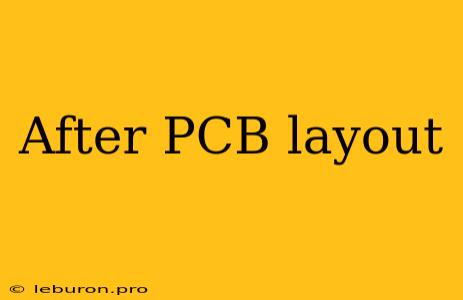The process of designing and manufacturing printed circuit boards (PCBs) is a multifaceted endeavor that requires a thorough understanding of various stages. One critical phase, following the initial PCB layout, is known as after PCB layout. This phase encompasses a series of crucial steps that are essential for ensuring the functionality, reliability, and manufacturability of the final PCB product. From comprehensive design rule checks to advanced simulation techniques, after PCB layout plays a pivotal role in bridging the gap between theoretical design and real-world implementation.
Design Rule Checks (DRC)
After the initial layout, the first crucial step in the after PCB layout phase is to perform Design Rule Checks (DRCs). This process involves verifying the PCB design against a set of predefined rules that ensure the manufacturability, functionality, and electrical integrity of the board. DRC software tools are employed to analyze the layout and identify any potential violations such as:
- Minimum trace widths and spacing: These rules define the minimum allowable dimensions for traces and spacing between them.
- Via and pad sizes: The minimum and maximum dimensions for vias and pads must be adhered to ensure proper soldering and component placement.
- Copper area restrictions: Certain areas of the PCB may have limitations on the amount of copper present due to heat dissipation or manufacturing constraints.
- Clearances and clearances: The PCB design must ensure sufficient clearances between components, traces, and other features to prevent short circuits or electrical interference.
By meticulously checking the PCB layout against these rules, potential design errors can be detected and corrected early on, minimizing the risk of costly rework or manufacturing issues.
Electrical Rule Checks (ERC)
In addition to DRC, electrical rule checks (ERC) are also conducted as part of the after PCB layout process. ERC tools focus on the electrical connectivity and functionality of the PCB design. They verify that:
- All connections are complete: The ERC ensures that all intended connections between components and traces are established.
- Netlists are accurate: The ERC checks the accuracy of the netlist, which defines the connections between various components and traces on the PCB.
- Component values are correct: The ERC verifies that all components are assigned the correct values and are connected according to the circuit design.
- No conflicts or short circuits exist: The ERC checks for any electrical conflicts or potential short circuits that could compromise the functionality of the PCB.
By thoroughly analyzing the electrical aspects of the PCB design, ERC helps identify and resolve potential problems before manufacturing begins, thus ensuring the circuit's intended functionality.
Simulation and Analysis
Simulation and analysis play a crucial role in the after PCB layout phase, allowing engineers to virtually test and evaluate the PCB design under various operating conditions. Some common types of simulations include:
- Signal integrity analysis: This type of simulation evaluates the performance of high-speed signals, including the rise and fall times, reflections, and crosstalk.
- Power integrity analysis: Power integrity analysis examines the voltage distribution and stability on the PCB, ensuring that components receive adequate power and that voltage drops and noise levels are within acceptable limits.
- Thermal analysis: Thermal simulations help predict the temperature distribution on the PCB, identifying potential hotspots that could affect component reliability.
- Electromagnetic analysis: This type of analysis evaluates the electromagnetic field distribution on the PCB, identifying potential interference issues between components or with external sources.
By performing these simulations, engineers can identify potential problems early on, optimize the design, and ensure the PCB's reliable performance under real-world conditions.
Manufacturing Considerations
The after PCB layout phase also involves considering manufacturing constraints and requirements. This step ensures that the design is easily fabricated and meets the desired quality standards. Some important considerations include:
- Board thickness and layer count: The chosen board thickness and layer count must be compatible with the manufacturing process.
- Component placement: Component placement needs to be carefully considered to ensure proper access for assembly and soldering.
- Solder mask and silkscreen: The solder mask and silkscreen layers must be designed to facilitate the assembly and identification of components.
- Test points and access: Provision for test points and access for in-circuit testing should be incorporated into the layout.
By taking these manufacturing considerations into account, the after PCB layout process helps minimize manufacturing challenges and ensure a smooth transition from design to production.
Documentation and Gerber Files
After completing the after PCB layout phase, it is crucial to generate accurate and comprehensive documentation. This documentation may include:
- PCB design specifications: A document outlining the key features and specifications of the PCB design.
- Bill of materials (BOM): A list of all the components used in the PCB design, including their part numbers and quantities.
- Gerber files: A set of digital files that define the layout and geometry of the PCB, used by the fabrication house to manufacture the board.
These documents provide a detailed description of the PCB design and serve as a reference for manufacturing and assembly.
Conclusion
The after PCB layout phase is a critical part of the PCB design process. It involves a meticulous examination of the layout to ensure its functionality, reliability, and manufacturability. By performing comprehensive design rule checks, electrical rule checks, simulations, and considering manufacturing constraints, engineers can optimize the PCB design and minimize the risk of errors or production issues. This meticulous approach ensures that the final PCB product meets the desired performance specifications and contributes to the success of the overall electronic system.
